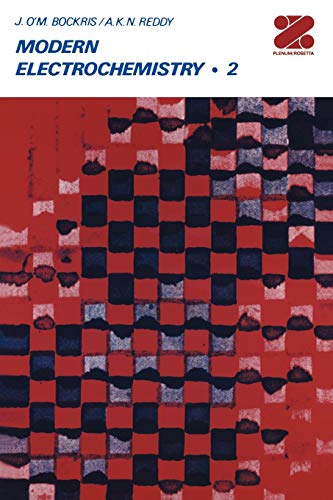Articoli correlati a Modern Electrochemistry: An Introduction to an Interdiscipli...

Le informazioni nella sezione "Riassunto" possono far riferimento a edizioni diverse di questo titolo.
Le informazioni nella sezione "Su questo libro" possono far riferimento a edizioni diverse di questo titolo.
- EditorePlenum Pub Corp
- Data di pubblicazione1973
- ISBN 10 0306250020
- ISBN 13 9780306250026
- RilegaturaCopertina flessibile
- Numero di pagine900
Compra nuovo
Scopri di più su questo articolo
Spese di spedizione:
GRATIS
In U.S.A.
I migliori risultati di ricerca su AbeBooks
Modern Electrochemistry: An Introduction to an Interdisciplinary Area, Vol. 2 by Bockris, John O'M., Reddy, Amulya K.N. [Paperback ]
Descrizione libro Soft Cover. Condizione: new. Codice articolo 9780306250026
Modern Electrochemistry: An Introduction to an Interdisciplinary Area
Print on DemandDescrizione libro Condizione: New. PRINT ON DEMAND Book; New; Fast Shipping from the UK. No. book. Codice articolo ria9780306250026_lsuk
Modern Electrochemistry : An Introduction to an Interdisciplinary Area
Descrizione libro Condizione: New. Codice articolo 658322-n
Modern Electrochemistry : An Introduction to an Interdisciplinary Area
Descrizione libro Condizione: New. Codice articolo 658322-n
Modern Electrochemistry
Print on DemandDescrizione libro Bundle. Condizione: New. Dieser Artikel ist ein Print on Demand Artikel und wird nach Ihrer Bestellung fuer Sie gedruckt. 7 The Electrified Interface.- 7.1 Electrification of an Interface.- 7.1.1 The Electrode-Electrolyte Interface: The Basis of Electrodics.- 7.1.2 New Forces at the Boundary of an Electrolyte.- 7.1.3 The Interphase Region Has New Properties and New Structures. Codice articolo 5901110
Modern Electrochemistry: An Introduction to an Interdisciplinary Area, Vol. 2
Descrizione libro Condizione: New. Codice articolo ABLIING23Feb2215580098052
Modern Electrochemistry
Descrizione libro Taschenbuch. Condizione: Neu. This item is printed on demand - it takes 3-4 days longer - Neuware -Springer Book Archives 900 pp. Englisch. Codice articolo 9780306250026
Modern Electrochemistry : An Introduction to an Interdisciplinary Area
Descrizione libro Taschenbuch. Condizione: Neu. Druck auf Anfrage Neuware - Printed after ordering - Springer Book Archives. Codice articolo 9780306250026
Modern Electrochemistry: An Introduction to an Interdisciplinary Area, Vol. 2
Descrizione libro Condizione: New. Codice articolo I-9780306250026

